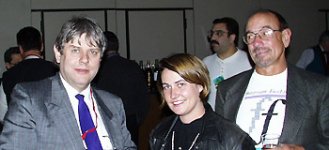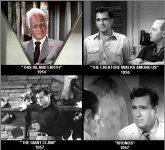Hi all,
I have a question for Mr. Pass
I read your explation about the sound trip through air, and the air rarefractation and compression, and I have to say that is very encouraging and suggestive, not to mention true and exact.
But after I while I started to think: That way is how "real" sound travels from instrument to microphone!! For synth music (i.e. music that only reaches air after getting out of the speakers), could be effective, but for "natural" or "acoustic" recorded music (i.e. music that has already had the trip and the effect of comp. and raref. from the air) I don't see the reason!!
I take the opportunity to say that I love your work, mainly the writing and the essence (because I haven't finished my Alep30 yet), and above that your PWOL (pass way of life: not even one of my company engineers of my dept. shares their ideas with anyone. That is... like you)
Thanks,
I have a question for Mr. Pass

I read your explation about the sound trip through air, and the air rarefractation and compression, and I have to say that is very encouraging and suggestive, not to mention true and exact.
But after I while I started to think: That way is how "real" sound travels from instrument to microphone!! For synth music (i.e. music that only reaches air after getting out of the speakers), could be effective, but for "natural" or "acoustic" recorded music (i.e. music that has already had the trip and the effect of comp. and raref. from the air) I don't see the reason!!
I take the opportunity to say that I love your work, mainly the writing and the essence (because I haven't finished my Alep30 yet), and above that your PWOL (pass way of life: not even one of my company engineers of my dept. shares their ideas with anyone. That is... like you)
Thanks,
The notion of air being single-ended simply leads me
to try single-ended amplification as a path to the sound
of electronics which best mimic natural phenomenon and
whose distortions are likely to be least offensive.
If you don't like this idea, I've got others....
😉
to try single-ended amplification as a path to the sound
of electronics which best mimic natural phenomenon and
whose distortions are likely to be least offensive.
If you don't like this idea, I've got others....
😉
I've got a theory that everyone has done single-ended wrong. Air is single ended because you can go up in pressure infinitely but can only go down 14 psi or so. With an N-channel FET, NPN bipolar, or a tube, you can go all the way up to the positive rail, but you can only go down to the device's saturation voltage. But remember, what we're dealing with is electron flow, which is negative particles.
So single-ended is a great approach, but everybody has picked the wrong end. It can only sound good if you're using a P-channel FET or a PNP bipolar. N-channels, tubes, and NPNs all exacerbate the single ended nature of air and are fundamentally wrong. It's like sucking across my flute's blowhole instead of blowing. It's like hitting a bass drum from the inside, using a clever midget with earplugs and a score. It's like dragging a violin across a bow.
So single-ended is a great approach, but everybody has picked the wrong end. It can only sound good if you're using a P-channel FET or a PNP bipolar. N-channels, tubes, and NPNs all exacerbate the single ended nature of air and are fundamentally wrong. It's like sucking across my flute's blowhole instead of blowing. It's like hitting a bass drum from the inside, using a clever midget with earplugs and a score. It's like dragging a violin across a bow.
??? Isn´t it pure arbitrariness to name this little bits of materia e- a negative one? I don´t get your idea.
Another point: as long as the single ended FET has same speed moving araound in both directiones between positive rail and saturation, is it really like air?
And what about temperatur , if i put some air in another pressure in very short time, it will react not only with the pressure i want, it will vary its temperaure. What should the poor e- do? become hot or cold???
Another point: as long as the single ended FET has same speed moving araound in both directiones between positive rail and saturation, is it really like air?
And what about temperatur , if i put some air in another pressure in very short time, it will react not only with the pressure i want, it will vary its temperaure. What should the poor e- do? become hot or cold???
It can only sound good if you're using a P-channel FET or a PNP bipolar.
Try reversing the polarity of your speaker wires....... I guess that it also depends on the phase in the recording. Maybe a phase switch is in order.
http://half.ebay.com/cat/buy/prod.cgi?cpid=549443&domain_id=1856&ad=55327
http://www.vansevers.com/Notes/Phase/phase.html
Now if you will excuse me, I have to go change since I wet my pants laughing.....
Turn the ship upside down Unk,
Fred
P.S. Hi Clark (the one of the right wing)
Try reversing the polarity of your speaker wires....... I guess that it also depends on the phase in the recording. Maybe a phase switch is in order.
http://half.ebay.com/cat/buy/prod.cgi?cpid=549443&domain_id=1856&ad=55327
http://www.vansevers.com/Notes/Phase/phase.html
Now if you will excuse me, I have to go change since I wet my pants laughing.....
Turn the ship upside down Unk,
Fred
P.S. Hi Clark (the one of the right wing)
Attachments
What does a hole weigh?
it depends on the enviroment it is in...(although weight is the wrong term...what is a hole...well...it's where an electron isn't)
and I think the concept you are referring to the "effective mass"
solid state...solid state.....that was over 20 years ago
1/137
it depends on the enviroment it is in...(although weight is the wrong term...what is a hole...well...it's where an electron isn't)
and I think the concept you are referring to the "effective mass"
solid state...solid state.....that was over 20 years ago
1/137
Conveniently, that is what we do with the Zen.
OK Fred, it's time to reveal the identity of the Avatar.
OK Fred, it's time to reveal the identity of the Avatar.
I think as long as you p device hasn´t a positronic flow (current) the holes only move if a e- is moved. So the mass you see here is the same as e-.
But why do the mass matters? For the current flow the weight isn´t important, see it as 0. Anotherr thing is if you have a piece of copper the e- are maybe some mm second, in semiconductores they are much faster (i hope i remember right). so they have to change their speed at every connection.
But why do the mass matters? For the current flow the weight isn´t important, see it as 0. Anotherr thing is if you have a piece of copper the e- are maybe some mm second, in semiconductores they are much faster (i hope i remember right). so they have to change their speed at every connection.
Phase, polarity and/or directionality.
"Wire has one practical dimension and two possible directions--each having its own characteristic sound."
Can anyone tell in what direction a wire is connected,
by listening to some music flowing through the wire?
How is this possible, if it is? 😕 😕
😕
"Wire has one practical dimension and two possible directions--each having its own characteristic sound."
Can anyone tell in what direction a wire is connected,
by listening to some music flowing through the wire?
How is this possible, if it is? 😕
 😕
😕hmm.
The direction you have to connect your cable depends.
If you are a Physicist you have to use the reverse direction than an Engineer. This is because of the currents direction is opposite to the electrons flow...
For everyone else it doesn´t matter.
The direction you have to connect your cable depends.
If you are a Physicist you have to use the reverse direction than an Engineer. This is because of the currents direction is opposite to the electrons flow...
For everyone else it doesn´t matter.
OK Fred, it's time to reveal the identity of the Avatar
Nelson, Nelson, Nelson..........
http://www.spookytoms.com/Jeff_Morrow_Tribute.html
And you call yourself a scientist,
Fred
http://twtd.bluemountains.net.au/Rick/liz.htm
Nelson, Nelson, Nelson..........
http://www.spookytoms.com/Jeff_Morrow_Tribute.html
And you call yourself a scientist,
Fred
http://twtd.bluemountains.net.au/Rick/liz.htm
Attachments
Well, I'm glad SOMEONE got it right. So the music through the p-channel Zen won't have that upside-down quality I hear with single-ended tubes?
Sometimes I have to listen standing on my head.
To neutralize the bad "upside-down" caracter of the music.






PS. To get some ease, I can turn my poweramp upside-down instead
for some hours. DS
To neutralize the bad "upside-down" caracter of the music.






PS. To get some ease, I can turn my poweramp upside-down instead
for some hours. DS
Air compression by sound may be single-ended but ....
.. it's insignificant compared to any single-ended amp design.
http://www.diyaudio.com/forums/showthread.php?s=&threadid=4015&highlight=air+pressure
13DoW
.. it's insignificant compared to any single-ended amp design.
http://www.diyaudio.com/forums/showthread.php?s=&threadid=4015&highlight=air+pressure
13DoW
Sometimes I have to listen standing on my head.
Did you ever try to turn your speakers 180° in horizontal axis?
(It works much better than turn you CDP, if its a top loader)
another symmetrie problem is easily solved by turning the speakers against a wall with a large mirror.
till, I haven't tried that, because it would bring the French Horns forward, quite unnatural. But turning my speakers 360 degrees straightened out a lot of phase problems I was hearing.
halojoy, that's not a good idea since I'm using a tube amp. Normally, the electrons follow a slightly curved path between cathode and plate due to gravity- all objects with mass and an initial acceleration follow a parabola. So, well-made tubes offset the cathode and the plate slightly, with the plate slightly lower. Turning the amp upside-down will cause the parabola to curve in the other direction. This reduces the effective area of the cathode and hence reduces transconductance.
halojoy, that's not a good idea since I'm using a tube amp. Normally, the electrons follow a slightly curved path between cathode and plate due to gravity- all objects with mass and an initial acceleration follow a parabola. So, well-made tubes offset the cathode and the plate slightly, with the plate slightly lower. Turning the amp upside-down will cause the parabola to curve in the other direction. This reduces the effective area of the cathode and hence reduces transconductance.
A friend of mine always dances his head forth and back to align the phase angle with the speakers.
Somewhat different movements to different music.
JH
Somewhat different movements to different music.
JH
LOLA friend of mine always dances his head forth and back to align the phase angle with the speakers.
If he moves his head in the same phase as the speaker what would he hear???
 Silence or a continius sonic boom?. I guess I'll have to try it out tomorrow and let you know the result😀
Silence or a continius sonic boom?. I guess I'll have to try it out tomorrow and let you know the result😀 Keld
Attachments
- Status
- Not open for further replies.
- Home
- Amplifiers
- Pass Labs
- Air compression

